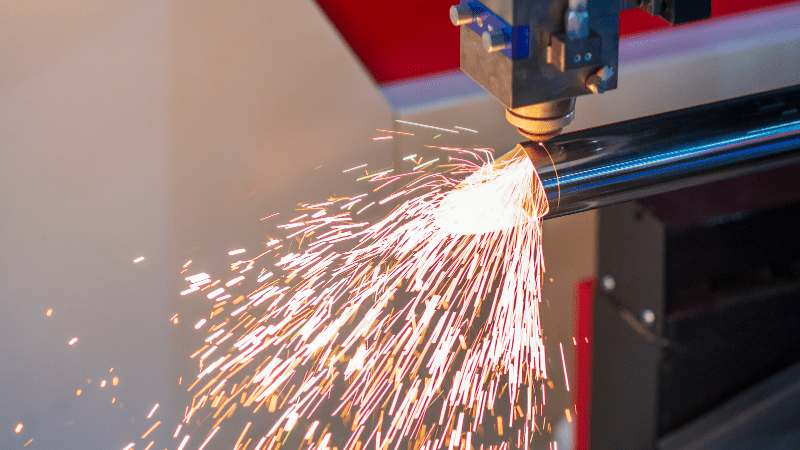Fiber laser-cutting technology is a step ahead of laser-cutting machines and is now widely used in manufacturing. This technology has enabled companies to achieve higher precision and efficiency in cutting processes while reducing production costs.
This article will explore the various aspects of fiber laser cutting machines, including their features, advantages, applications, and maintenance requirements. Whether you are a business owner, engineer, or simply interested in learning more about this technology, this guide will provide all the information you need to understand and utilize fiber laser cutting machines to their fullest potential.
What is a Fiber Laser Cutting Machine?
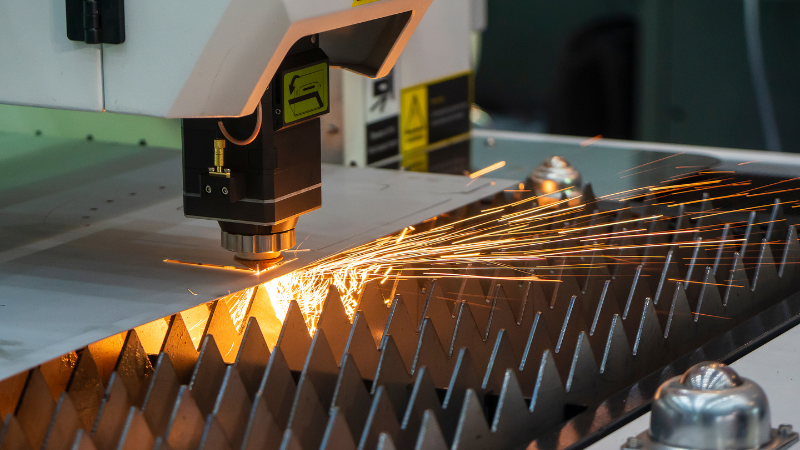
A fiber laser cutting machine is an industrial laser cutting equipment that uses a high-powered fiber laser to cut through various materials with high precision and accuracy. Fiber-cutting machines suit thin, mild, and thick metal sheets and tubes. They are specifically good for cutting stainless steel and non-ferrous materials. with 500W plus laser power, and they can cut through very thick materials.
How Does a Fiber Laser Cutting Machine Work?
A fiber laser cutting process uses a high-power laser beam to cut through various materials. The machine produces a high-intensity laser beam using a fiber laser source. The laser beam hits where it is directed through the machine’s optical path. The laser beam is focused on the material being cut using a lens. This concentrates the laser’s energy onto a small area of the material.
The focused beam heats and vaporizes the material, creating a narrow cut. The machine’s computer-controlled positioning system guides the beam along the desired cutting path.
The laser beam melts and vaporizes the material as it cuts, and a high-pressure gas jet removes the molten material from the cut, leaving a clean and precise cut edge.
Use of Fiber Laser Cutting Machines on an Industrial Scale
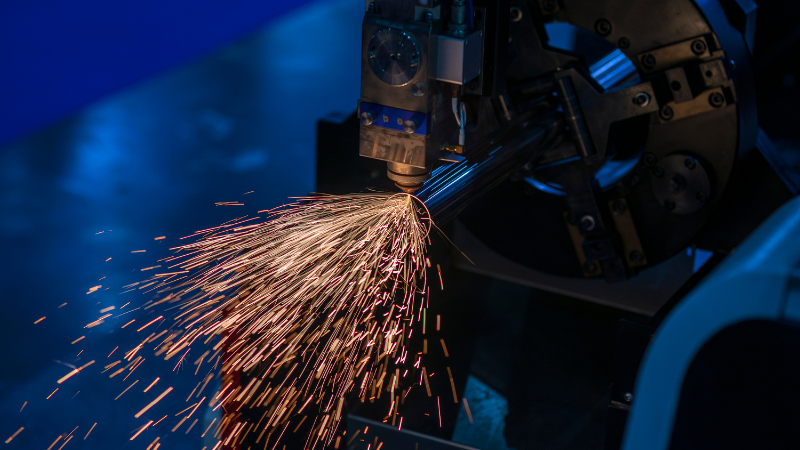
Fiber laser cutting machines are used in a wide range of applications across various industries, including:
Metalworking: Fiber laser cutting is used for cutting, engraving, and marking various metals such as stainless steel, aluminum, copper, brass, and more. They are commonly used in metal fabrication, sheet metal processing, and metalworking industries.
Automotive: Fiber laser cutting machines are used in the automotive industry for cutting various components, such as body parts, frames, exhaust systems, and more.
Aerospace: Fiber laser cutting machines are used in the aerospace industry for cutting various materials, such as titanium, aluminum, and composites, for the production of aircraft components.
Electronics: Fiber laser cutting machines are used in the electronics industry for cutting, drilling, and marking various components, such as circuit boards, connectors, and sensors.
Medical: Fiber laser cutting machines are used in the medical industry for cutting and marking various materials, such as surgical instruments, implants, and medical devices.
Jewelry: Fiber laser cutting machines are used in the jewelry industry to cut, engrave, and mark precious metals and gemstones.
Small Scale Manufacturing with Fiber Laser Cutting Machines
Some small-scale applications of fiber laser cutting machines are:
Jewelry Making: Fiber laser cutting machines are used to cut intricate designs on metal jewelry with high precision and speed.
Sign Making: Fiber laser cutting machines can cut precise shapes and letters for sign making. This is useful for small businesses and local shops that need custom signage.
Model Making: Fiber laser cutting machines can cut and etch various wood, plastic, and acrylic materials to create precise models and prototypes.
Craft Making: Fiber laser cutting machines are ideal for small-scale crafting businesses that require cutting intricate designs on various materials such as paper, cardstock, and fabric.
Factors that Affect the Fiber Laser Machine
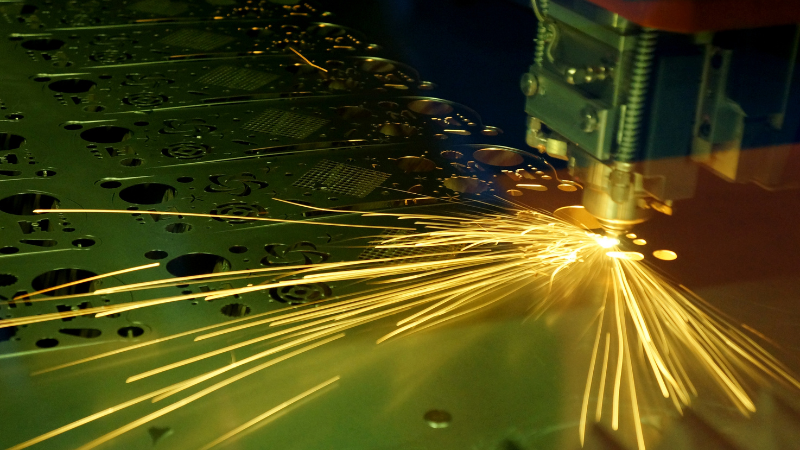
Several factors can affect the performance of fiber laser cutting machines. Here are some of the most significant ones:
Laser Power
The power of the laser used in the cutting process can significantly impact the cutting speed and quality. Higher laser power generally results in faster and smoother cuts, but it can also increase the cost of the machine.
Material type and thickness
Different materials have different properties that can affect how a fiber laser cuts them. For example, thicker materials may require higher laser power to cut through, while some materials may reflect the laser beam and require additional measures to ensure a successful cut.
Cutting speed
The speed at which the fiber laser generator moves across the material can affect the quality of the cut, particularly when cutting thicker materials. Slower speeds may improve cutting efficiency and increase production time and cost.
Focus position
The position of the laser focus relative to the material being cut can affect the quality and precision of the cut. Improper focus position can result in uneven cuts or even damage to the material.
Gas pressure and type
The type and pressure of gas used in the cutting process can affect the quality of the cut and the speed at which it is made. Oxygen and nitrogen are commonly used gases in fiber laser cutting, and the pressure of these gases can be adjusted to optimize cutting performance.
Maintenance and calibration
Proper maintenance and calibration of the machine can ensure that it performs at its best and consistently produces high-quality cuts. Neglecting maintenance and calibration can result in decreased performance and increased downtime.
CO2 VS Fiber Laser Cutting Machines
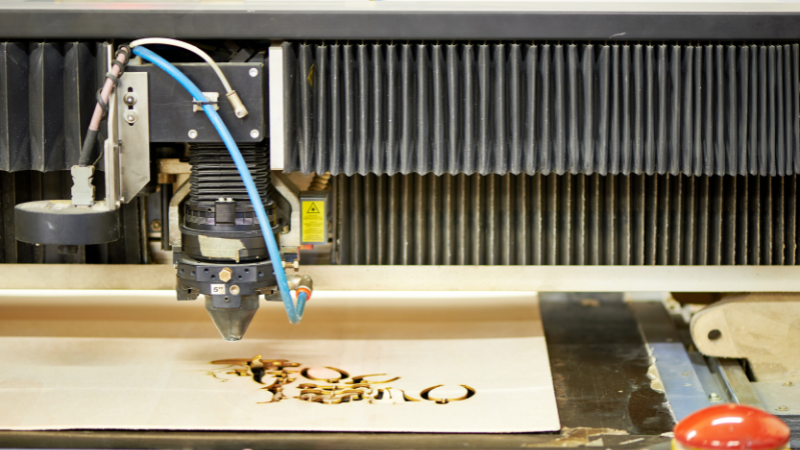
CO2 laser cutting machines are the other popular type of laser machine used in various industries. While both types of machines use lasers to cut materials, there are some key differences between them.
CO2 laser cutting machines use a gas mixture composed of carbon dioxide to generate the laser beam. These machines typically cut non-metal materials such as plastics, wood, fabrics, and thin metal sheets.
On the other hand, fiber laser cutting machines use a solid-state laser source, typically made from a fiber optic cable doped with rare earth elements. These machines are ideal for cutting various materials, including metals, ceramics, plastics, and composites.
Fiber laser cutting machines are generally faster and more precise than CO2 laser cutting machines. That is because the wavelength of the fiber laser is shorter than that of a CO2 laser, which allows for greater precision and faster cutting speeds. Fiber lasers are also more energy-efficient, producing less heat and using less power than CO2 lasers.
In terms of cost, CO2 laser cutting machines are generally less expensive than fiber laser cutting machines, especially for lower-powered models. However, fiber laser machines offer greater long-term cost savings due to their energy efficiency and lower maintenance requirements.
Ultimately, the choice between a CO2 laser cutting machine and a fiber laser cutting machine will depend on the specific needs and requirements of the user.
Metal VS Fiber Laser Cutting Machines
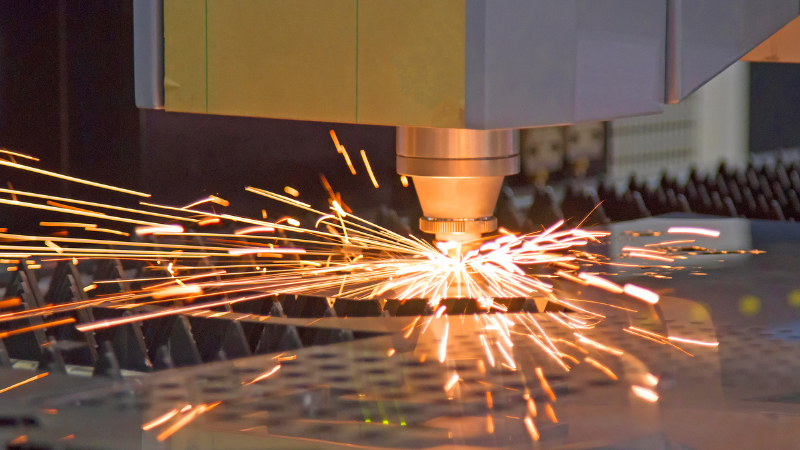
Metal cutting machines and fiber laser cutting machines are used for cutting metal, but they use different technologies and have different advantages and disadvantages.
Metal cutting machines use mechanical force and cutting tools such as saws, drills, and milling machines to remove material from a metal workpiece. These machines are generally slower than laser cutters and require more maintenance, but they can be more cost-effective for certain jobs and materials.
Fiber laser cutting machines, on the other hand, use a high-powered laser beam to melt and vaporize material from the workpiece. This process is faster and more precise than mechanical cutting and can be used on a wider range of materials, including metals, plastics, and composites. Fiber laser cutters also have lower maintenance requirements and can be more energy-efficient.
When deciding between metal and fiber laser cutting machines, it’s important to consider the job’s specific needs. A metal cutting machine may be sufficient and more cost-effective for smaller or simpler jobs. However, a fiber laser cutting machine may be better for larger or more complex jobs requiring higher precision and a wider range of materials.
CNC VS Fiber Laser Cutting Machines
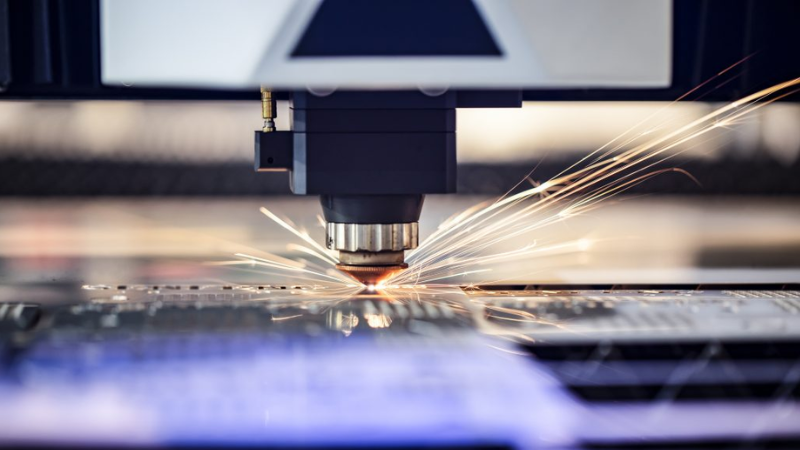
CNC laser cutting machines (Computer Numerical Control System) also cut various materials precisely, but their underlying technology and applications differ.
CNC machines are used in various industries, from woodworking to metalworking. They work by following a programmed set of instructions to control the movement of a cutting tool, such as a drill, router, or saw blade.
The cutting tool is mounted on a movable platform that can move in multiple directions, allowing for complex cuts and shapes to be made. CNC machines are versatile and can work with various materials, including metal, wood, plastics, and composites.
Fiber laser cutting machines, on the other hand, are specialized tools used primarily for metal cutting surfaces. They use a high-powered fiber laser to melt and vaporize the metal, creating a clean and precise cut. Fiber lasers can cut through thick metals quickly and accurately, making them ideal for industrial applications such as metal fabrication and manufacturing.
Fiber laser cutting machines offer several advantages over CNC machines, including faster cutting speeds, higher precision, and lower maintenance requirements. They also produce less waste material and can be used to cut a wider range of metals.
However, fiber laser cutting machines are more expensive than CNC machines and less versatile. They also require specialized training and safety precautions to operate. Ultimately, the choice between a CNC machine and a fiber laser cutting machine will depend on the specific needs of the user and the materials they work with.
Advantages of Fiber Laser Cutting Machines
Here are some of the advantages of fiber laser cutting machines:
Speed: Fiber laser cutting machines are much faster than CO2 laser cutting machines. This is because fiber lasers have a much higher power density, allowing them to cut through thicker materials much faster.
Precision: Fiber laser cutting machines are precise that can cut shapes and designs with high accuracy. This is due to their small laser cutting head, spot size, and ability to maintain focus over long distances.
Cost-effective: Fiber laser cutting machines are more cost-effective than CO2 laser cutting machines because they consume less energy, require less maintenance, and have a longer lifespan.
Versatility: Fiber laser cutting machines can cut a wide range of materials, including metals, plastics, carbon steel, and ceramics, making them a versatile choice for many applications.
Automation: Fiber laser cutting machines can be fully automated, allowing continuous, uninterrupted production. They can also be integrated with other manufacturing processes, such as welding and bending.
Environmental friendly: Fiber laser cutting machines produce less waste and consume less energy than traditional CO2 laser cutting machines, making them more environmentally friendly.
Overall, the advantages of fiber laser cutting machines make them a popular choice for various metal cutting applications, from small-scale prototyping to large-scale industrial production.
Factors to Consider before Selecting the Fiber Laser Cutting Machines
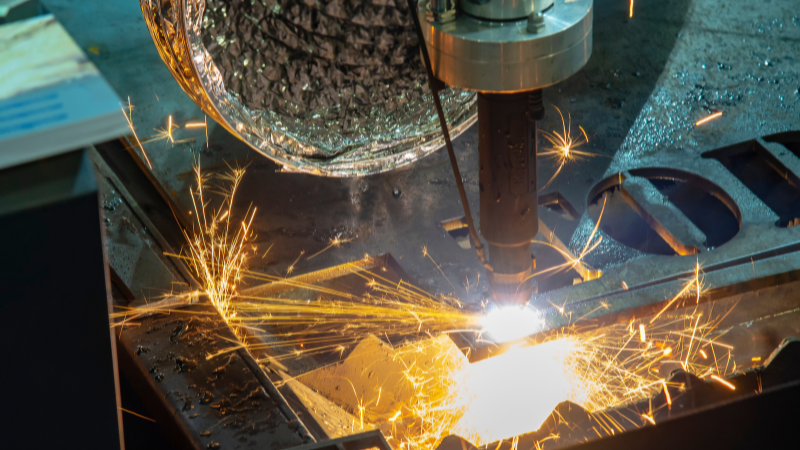
Here are a few thighs to consider while selecting the fiber laser cutting machine.
Cutting Material
The most important thing to consider is what material you need to cut. Fiber lasers suits for cutting tough materials like steel and stainless steel.
Cutting Capacity
Another thing to consider is the machine’s cutting capacity. You’ll want to ensure the machine can handle the cutting thickness and size of the materials you plan to cut. It’s a common misconception that high power is a good solution for all thicknesses.
Power
Laser-cutting power is also an important consideration. Higher power machines are capable of cutting thicker materials at a faster rate. The laser power setting allows you to adjust the cutting material’s power. Cutting a thin material with very high power may give a poor cut.
Cutting Speed
The appropriate cutting speed of the machine will affect your production efficiency. Choose a machine with a cutting speed that matches your production needs.
Maintenance
Maintenance is an important consideration, so choose a machine that is easy to maintain and has a low upkeep cost.
Price
Finally, you’ll need to consider the machine’s price. Determine your budget and choose a machine that offers the features you need at a price point you can afford.
How to Maintain Fiber Laser Cutting Machines?
Maintaining a fiber laser cutting machine is crucial to ensure optimal performance and increased lifespan. Here are some general steps to follow:
Keep the Machine Clean
Regularly clean the machine’s surfaces, including the cutting table and the optics, to prevent debris and dust build-up that can affect the machine’s accuracy and performance.
Check and Replace Consumables
Regularly inspect the machine’s consumables, such as nozzles, lenses, and protective windows. Replace any damaged or worn-out parts promptly to prevent further damage to the machine.
Lubricate Moving Parts
Lubricate the machine’s moving parts regularly to ensure smooth operation and prevent premature wear and tear.
Monitor and Adjust the Beam Alignment
Ensure that the machine’s laser head alignment is always on target. Regularly monitor the alignment and make any necessary adjustments.
Keep the Machine’s Software Updated
Keep the machine’s software up-to-date to use new features and performance enhancements.
Train Operators
Properly train operators on how to operate and maintain the machine to prevent improper use that can cause damage to the machine.
Regular Maintenance
Schedule regular maintenance with a qualified technician to inspect and tune up the machine for optimal performance.
Baison Fiber Laser Cutting Machines
Baison specializes in providing high-quality fiber metal laser cutting machines for industrial use. Our machines are suitable for various applications, from small to large-scale operations. We offer state-of-the-art fiber laser cutting machines for small, medium, and big manufacturers.
We offer fiber laser cutting machines for sheets and multifunctional systems to cut both sheets and tubes of various thicknesses. Our cutting-edge technology makes these machines precisely and accurately cut various materials, including steel, aluminum, copper, and brass.
Baison’s fiber laser cutting machines are designed to be user-friendly, efficient, and reliable, making them an excellent investment for any manufacturing business looking to increase productivity and reduce costs. They also offer excellent customer support and service to ensure their customers get the most out of their machines.
Final Words
In conclusion, fiber laser cutting machines have revolutionized the manufacturing industry by providing a faster, more efficient, and cost-effective solution for cutting and engraving various materials. Their advanced technology and high precision make them ideal for various applications, from automotive and aerospace to electronics and medical devices.
Moreover, their energy efficiency and low maintenance requirements make them an eco-friendly choice that can significantly reduce energy costs and carbon emissions.
As fiber laser cutting machines continue to evolve and improve, we expect more widespread adoption across industries and increased innovation in their capabilities. Whether you are a small business owner or a large manufacturing company, investing in a fiber laser cutting machine can help you stay ahead of the competition and meet the demands of your customers.
Upgrade Your Manufacturing Process with Our Fiber Laser Cutting Machines
Are you looking to streamline your manufacturing process and increase efficiency? Our fiber laser cutting machines are the solution you need. With cutting-edge technology and precision, our machines are designed to deliver high-quality results that meet the demands of even the most complex projects.
From metal fabrication to automotive manufacturing, our fiber laser cutting machines are versatile and can handle various materials and applications. With faster cutting speeds and reduced downtime, our machines will help you save time and money while increasing your production capacity.
Contact us for a quote and learn more about how our fiber laser-cutting machines can transform your business. You can contact us for a free application evaluation if you don’t know which of our laser systems best suits your needs.

